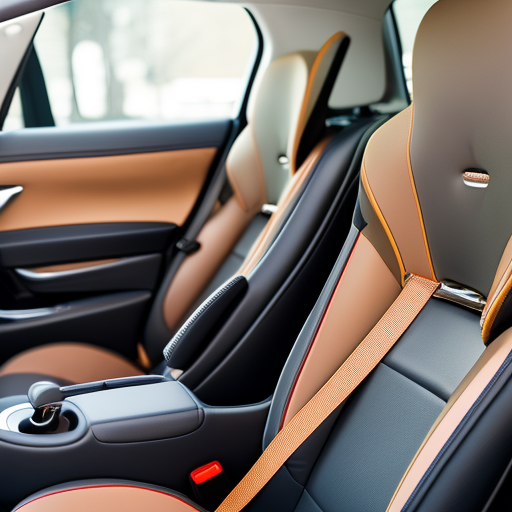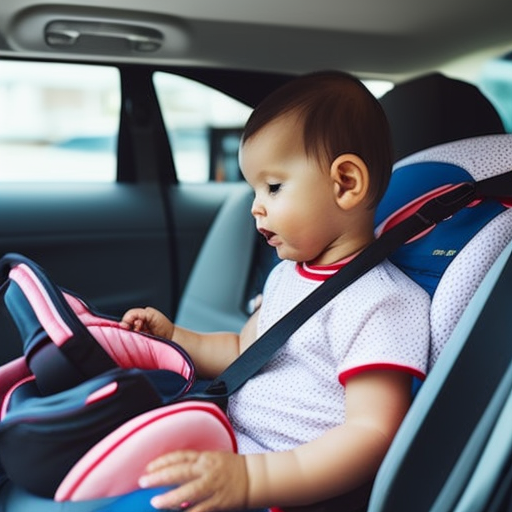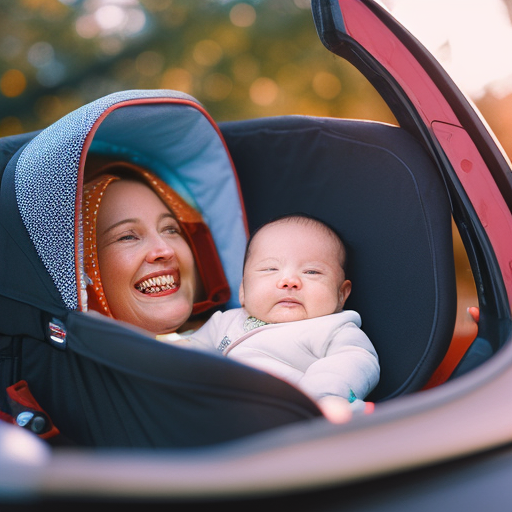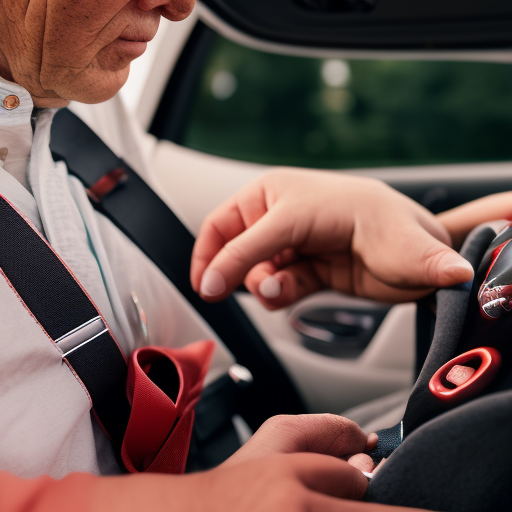"Cherishing Little Steps - A Haven for Baby and Family Journeys"
Infant Car Safety Tips
You love your little one more than anything in the world, and keeping them safe is your number one priority.
Just like a shield protects a knight, a car seat is your armor of protection for your precious baby while on the road.
In this guide, we will share essential infant car safety tips to ensure your child’s well-being during every car ride.
From choosing the right car seat to understanding regulations, installing it properly, and adjusting the harness straps correctly – we’ve got you covered.
We’ll also discuss the importance of keeping your baby rear-facing, monitoring the temperature in the car, avoiding distractions, and knowing what to do in case of an emergency.
Let’s dive in and make every journey a safe and secure one.
Key Takeaways
- Choose a car seat that is appropriate for your baby’s age and size, ensuring proper head and neck support and safety features like a five-point harness system.
- Install the car seat correctly following the manufacturer’s instructions, positioning it in the back seat and securing it using seat belts or the LATCH system.
- Adjust and position the car seat properly, checking the tightness of the harness, positioning the chest clip at armpit level, and achieving a secure and comfortable fit for your child.
- Stay informed about the latest car seat regulations and guidelines, regularly check for updates and recalls, and maintain the car seat by cleaning and sanitizing it regularly.
Choosing the Right Car Seat

Choose the right car seat for your infant to ensure their safety while traveling. With so many car seat brands and car seat safety reviews available, it can be overwhelming to make a decision. However, by following a few simple guidelines, you can find the perfect car seat for your little one.
Firstly, consider the age and size of your baby. Infant car seats are designed for newborns up to a certain weight limit, usually around 30 pounds. Look for a seat that offers proper head and neck support for your infant.
Next, check for safety features. Look for car seats that have a five-point harness system, as this offers the most secure fit. Additionally, ensure that the car seat is easy to install and has passed rigorous safety tests.
When it comes to car seat brands, reputable names such as Graco, Chicco, and Britax are known for their quality and safety. Do some research and read car seat safety reviews to get an idea of which brands are highly recommended by other parents.
Understanding Car Seat Regulations

To ensure the safety of your infant while traveling, it’s important to understand and comply with car seat regulations. Here are some key points to keep in mind:
-
Choosing the right car seat: Selecting the appropriate car seat for your child’s age and weight is crucial. Consider factors such as the seat’s weight and height limits, as well as its safety features, such as side-impact protection and a five-point harness system. Look for car seats that have been tested and approved by regulatory agencies, such as the National Highway Traffic Safety Administration (NHTSA).
-
Installing the car seat properly: Once you have chosen the right car seat, it’s essential to install it correctly. Follow the manufacturer’s instructions carefully and make sure the seat is securely attached to the vehicle. Use the seat belts or the lower anchors and tethers for children (LATCH) system to secure the car seat. Double-check that the seat is snug and doesn’t move more than an inch in any direction.
-
Understanding car seat regulations: Stay informed about the latest car seat regulations and guidelines. These regulations may vary by country or state, so it’s essential to be aware of the specific requirements in your area. Regularly check for any updates or recalls related to your car seat model to ensure that it continues to meet safety standards.
Installing the Car Seat Properly

Ensure your infant’s safety by properly installing the car seat. Choosing the right car seat is crucial to providing maximum protection for your child while on the road. There are different types of car seats available, including rear-facing, forward-facing, and convertible car seats. It’s important to select a car seat that’s appropriate for your child’s age, weight, and height.
Once you have chosen the right car seat, it’s essential to follow the manufacturer’s instructions for installation. Proper installation ensures that the car seat is securely fastened and will effectively protect your child in the event of an accident. Here are some key steps to remember when installing your car seat:
- Read the car seat manual thoroughly before installation to understand the specific guidelines and requirements.
- Position the car seat in the back seat of the vehicle, preferably in the middle.
- Secure the car seat using either the vehicle’s seat belt or the LATCH system, which stands for Lower Anchors and Tethers for Children.
- Adjust the harness straps correctly to ensure a snug fit. The straps should be at or below your child’s shoulders and should be tight enough that you can only fit one finger between the strap and your child’s chest.
Adjusting the Harness Straps Correctly
To properly protect your child in the car, it’s important to adjust the harness straps correctly on the car seat. Proper strap adjustment ensures a secure and comfortable fit for your little one. Here are some tips to help you achieve the perfect harness fit:
-
Check the tightness: The harness should be snug, with no slack. You shouldn’t be able to pinch any excess fabric. A snug fit prevents your child from moving around in the event of a crash.
-
Position the chest clip correctly: The chest clip should be at armpit level. This helps distribute the force of a crash across the strongest parts of your child’s body, reducing the risk of injury.
-
Adjust the shoulder straps: The shoulder straps should be threaded through the slots that are at or below your child’s shoulders. If they’re too high, they can cause discomfort and may not provide adequate protection in a crash.
Remember, every car seat is different, so be sure to consult the manufacturer’s instructions for specific guidelines on adjusting the harness straps.
Taking the time to properly adjust the harness straps will give you peace of mind, knowing that your child is safe and secure during every car ride.
Positioning the Car Seat in the Vehicle

Place the car seat securely in the back seat of your vehicle. Proper car seat installation is crucial for the safety of your infant during car rides. Follow these guidelines to ensure you are securing the car seat properly:
| Step | Description | Tips |
|---|---|---|
| 1 | Position the car seat | Place the car seat in the center of the back seat. This provides the most protection from side impacts. |
| 2 | Angle the car seat | Ensure that the car seat is reclined at the proper angle. For infants, it should be at a 45-degree angle to keep their airways open. Use the recline indicator on the car seat or consult the owner’s manual for guidance. |
| 3 | Secure the car seat | Use the vehicle’s seat belt or LATCH system to secure the car seat. Pull the seat belt tight or attach the LATCH connectors securely. Wiggle the car seat to check for any movement. It should not move more than an inch side to side or front to back. |
Securing the Car Seat With Seat Belts or LATCH System

Secure the car seat in your vehicle using either the seat belts or the LATCH system. Both methods are safe and effective ways to ensure your baby’s car seat stays securely in place during travel. Here are some important points to consider:
-
Using Seat Belts:
-
Make sure the seat belt is threaded correctly through the car seat.
-
Pull the seat belt tight to remove any excess slack.
-
Lock the seat belt by engaging the locking mechanism or using a locking clip.
-
Test the car seat’s stability by giving it a firm tug at the base. It shouldn’t move more than an inch in any direction.
-
Installing LATCH System:
-
Locate the lower anchors in your vehicle, which are typically found in the crease of the seat.
-
Attach the lower anchors to the LATCH connectors on the car seat. Make sure they’re securely fastened.
-
Use the top tether strap to provide additional stability. Attach it to the designated anchor in your vehicle.
-
Press down on the car seat and pull on the straps to ensure a tight fit. The car seat shouldn’t move more than an inch in any direction.
Avoiding Common Car Seat Mistakes

Make sure you’re aware of common car seat mistakes to ensure your baby’s safety during car rides. Proper car seat installation and harness adjustment are crucial for keeping your little one secure and protected.
When it comes to car seat installation, one common mistake isn’t following the manufacturer’s instructions. Make sure you carefully read the manual and understand how to install the car seat correctly. Another mistake isn’t using the appropriate installation method for your specific car seat. Some car seats can be installed using either the seat belts or the LATCH system, so make sure you use the method recommended by the manufacturer.
Proper harness adjustment is also essential for your baby’s safety. One common mistake isn’t tightening the harness enough. The straps should be snug against your baby’s body, with no slack. You should also make sure that the chest clip is positioned at armpit level to keep the straps in the correct position. Another mistake is using bulky clothing or blankets that can interfere with the harness. It’s important to dress your baby in thin layers and use a blanket over the harness to keep them warm without compromising their safety.
Checking the Car Seat for Recalls or Expiration Dates

Check your car seat regularly for any recalls or expiration dates to ensure the continued safety of your infant during car rides. It’s important to stay updated on any recalls that may affect your car seat, as they can pose serious risks to your child’s safety. Additionally, car seats have expiration dates, typically ranging from 6 to 10 years after the date of manufacture. Using an expired car seat can compromise its effectiveness in protecting your infant in the event of a crash.
To help you understand the importance of checking for recalls and expiration dates, consider the following:
-
Recalls:
-
Manufacturers issue recalls to address safety issues in their car seats.
-
Check the manufacturer’s website or the National Highway Traffic Safety Administration (NHTSA) website for any recalls affecting your car seat model.
-
Follow the instructions provided by the manufacturer to address the recall promptly.
-
Expiration dates:
-
Car seats are made from materials that can degrade over time, affecting their structural integrity.
-
Check the car seat’s label for the expiration date, which is typically printed on the bottom or back of the seat.
-
Using an expired car seat may not provide the necessary protection in a crash.
Keeping Your Baby Rear-Facing as Long as Possible

To ensure the continued safety of your infant during car rides, it’s important to keep your baby rear-facing as long as possible. Extended rear-facing benefits are numerous and debunk common myths surrounding this practice.
Research has shown that rear-facing car seats provide optimal protection for your baby’s head, neck, and spine in the event of a collision. By facing the seat towards the rear of the car, the force of impact is distributed evenly across the entire seat, reducing the risk of injury.
Contrary to popular belief, it isn’t necessary to transition to forward-facing once your child reaches a certain age or weight. The American Academy of Pediatrics recommends keeping your child rear-facing until they reach the maximum weight or height limit specified by the car seat manufacturer. Safety experts advise waiting until at least the age of two before transitioning to forward-facing.
Monitoring the Temperature in the Car

To ensure your baby’s utmost comfort and safety, it’s important to monitor the temperature in the car. Here are some tips to help you prevent overheating and ensure a comfortable ride for your little one:
-
Check the temperature: Before getting into the car, check the outside temperature and consider how it might affect the inside of your vehicle. On hot days, the temperature inside a car can rise rapidly, even with the windows cracked.
-
Use sunshades: Install sunshades on the windows to block direct sunlight and help keep the car cooler. This can significantly reduce the heat inside the car and protect your baby from the sun’s harmful rays.
-
Keep air circulating: Make sure that the air conditioning or ventilation system is working properly. If your car doesn’t have adequate air conditioning, consider using a small fan to circulate the air around your baby.
Remember, babies are more sensitive to temperature changes than adults, and overheating can be dangerous. Keep an eye on your baby for signs of discomfort or excessive sweating, as these may be indications that the car is too hot.
Avoiding Distractions While Driving With Your Baby

Ensure a distraction-free driving experience by minimizing any potential hazards that may divert your attention away from the road while traveling with your baby. Distractions management is crucial to maintain the safety of both you and your little one. Safe driving techniques are essential, especially when you have a precious cargo on board.
First and foremost, it’s important to keep your focus on the road. Avoid activities that may take your attention away, such as texting, making phone calls, or eating while driving. Remember, even a momentary distraction can have serious consequences.
To further minimize distractions, it’s recommended to secure your baby properly in a car seat. Make sure the car seat is installed correctly and the harness is snug. This will prevent you from being distracted by a fussy or unsecured baby while driving.
Additionally, consider organizing your baby’s essentials in a way that they’re easily accessible. This way, you won’t have to reach or search for items while driving, reducing the likelihood of being distracted. Keep items like toys, snacks, and a spare pacifier within arm’s reach.
Lastly, if your baby needs attention while on the road, safely pull over to a designated area before tending to their needs. This ensures that your full attention is on your baby and not divided between driving and attending to them.
Knowing What to Do in Case of an Emergency
In case of an emergency while driving with your baby, it’s important to be prepared and know what actions to take. Your prompt response can make all the difference in ensuring the safety and well-being of your little one. Here are some essential emergency response tips and first aid techniques to keep in mind:
-
Stay calm: Take a deep breath and try to remain calm. Panicking can hinder your ability to think clearly and act effectively.
-
Assess the situation: Quickly evaluate the severity of the emergency. Is your baby conscious and breathing? Are there any visible injuries? This will help you determine the appropriate course of action.
-
Call for help: Dial emergency services immediately if the situation requires medical assistance. Describe the situation clearly and provide your location.
-
Administer basic first aid: If your baby is unconscious or not breathing, perform CPR if you’re trained to do so. For bleeding, apply pressure using a clean cloth or your hand.
-
Follow instructions: If emergency services provide instructions over the phone, follow them carefully. They’re trained professionals who can guide you through the situation.
Frequently Asked Questions
Can My Baby Be in a Car Seat With a Puffy Winter Coat?
You shouldn’t put your baby in a car seat with a puffy winter coat because it can create a gap between the harness and your baby, reducing the effectiveness of the seat. Consider using alternatives like blankets or thin layers for warmth.
How Often Should I Check My Car Seat for Recalls or Expiration Dates?
You should regularly check your car seat for recalls or expiration dates to ensure your child’s safety. Following child car seat safety guidelines is crucial, so don’t forget to stay up to date.
What Should I Do if My Baby’s Legs Are Touching the Back of the Vehicle Seat?
If your baby’s legs are touching the back of the vehicle seat, it’s important to adjust the car seat properly. Ensure that the seat is reclined at the correct angle to provide comfort and safety for your little one.
How Can I Prevent My Baby From Unbuckling Their Car Seat Straps?
To prevent your baby from unbuckling their car seat straps, ensure they are securely fastened and snug. Double-check the straps regularly for proper positioning and tightness. Prioritize car seat safety for infants.
Is It Safe to Use a Second-Hand Car Seat for My Baby?
Yes, it’s safe to use a second-hand car seat for your baby as long as it meets safety standards, hasn’t expired, and hasn’t been in a crash. Make sure to install it correctly and use proper harnessing techniques.
Conclusion
In conclusion, ensuring the safety of your infant during car rides is of utmost importance. By following the recommended car safety tips, such as choosing the right car seat, installing it correctly, and keeping your baby rear-facing for as long as possible, you can greatly reduce the risk of injuries.
While some may argue that these precautions are time-consuming, remember that your child’s safety should always be the top priority. Taking these measures will provide peace of mind and protect your little one on the road.


